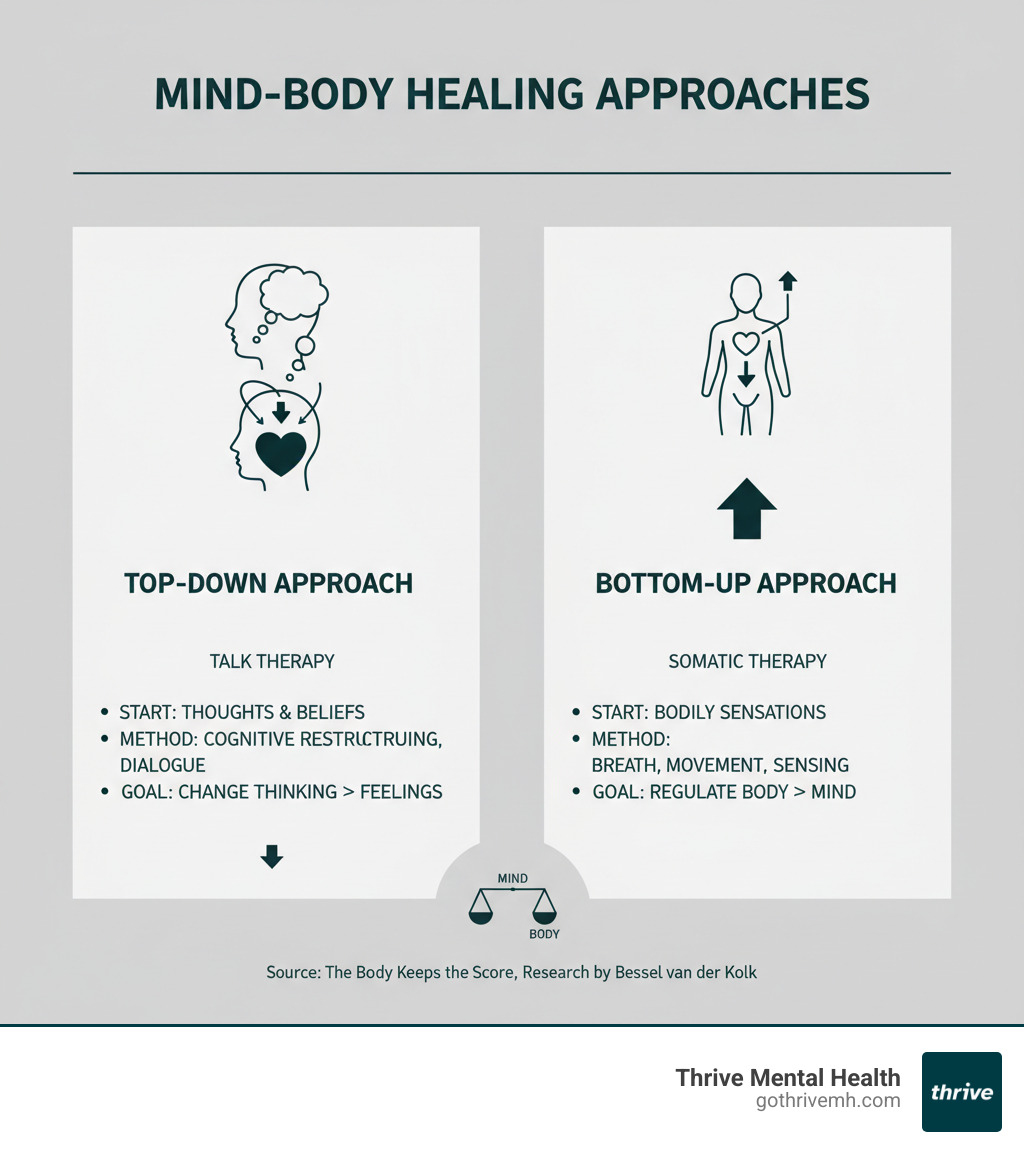Body Talk: The Real Evidence Behind Somatic Therapy

Somatic therapy evidence based: 44% Healing Power
Somatic Therapy Evidence Based [2025]: 44% PTSD Remission—Start Now or Stay Stuck
If you’re in crisis, call/text 988 right now. You are not alone.
Somatic therapy evidence based research is finally catching up to what trauma survivors have long known: healing happens through the body, not just the mind. While traditional talk therapy focuses on thoughts and behaviors, somatic approaches work directly with physical sensations, breathing, and movement to process trauma and stress.
Quick Answer: Is Somatic Therapy Evidence-Based?
- Yes, emerging research supports somatic therapy effectiveness
- Studies show large effect sizes (Cohen’s d > 0.8) for PTSD and depression symptoms
- Systematic reviews in Journal of Traumatic Stress confirm positive outcomes
- 44.1% of PTSD patients achieved remission in controlled trials
- fMRI studies show measurable brain changes after somatic interventions
- More rigorous research is ongoing, but current evidence is promising
The popularity surge began with The Body Keeps the Score, which spent over four years on the New York Times bestseller list. Dr. Bessel van der Kolk’s groundbreaking work introduced millions to a simple but idea: trauma lives in the body.
Unlike cognitive behavioral therapy (CBT) that works “top-down” by changing thoughts to influence feelings, somatic therapy works “bottom-up.” It starts with what your nervous system is actually experiencing right now – the tight chest, the shallow breathing, the tense shoulders that hold years of stress.
But does it actually work? As busy professionals dealing with anxiety and depression, you need more than compelling theories. You need evidence.
As Anna Green, LMHC, LPC and Chief Clinical Officer at Thrive Mental Health, I’ve integrated somatic approaches including EMDR and body-based interventions into evidence-based treatment programs for complex trauma presentations. My experience with somatic therapy evidence based practice shows these methods can be particularly effective when traditional talk therapy feels stuck or overwhelming.

Basic somatic therapy evidence based vocab:
How Somatic Therapy Rewires Your Nervous System—Fast Relief Without Rehashing Trauma
Think of your body as a library that stores every experience you’ve ever had. Somatic therapy evidence based approaches work on a simple but profound principle: your body remembers what your mind tries to forget.
Traditional talk therapy works from the top down – we analyze thoughts, discuss patterns, and hope those insights trickle down to change how we feel. But somatic therapy flips this script entirely. It starts with what’s happening in your body right now: that knot in your stomach during meetings, the way your shoulders creep toward your ears when stressed, or why certain situations make you feel like you can’t breathe.
This bottom-up processing recognizes something crucial – trauma doesn’t just live in our memories. It gets stored in our muscles, our breathing patterns, and our nervous system’s default settings. When we experience overwhelming stress or trauma, our body’s alarm system can get stuck in the “on” position, even when the danger has passed.
Your autonomic nervous system is like your body’s security team, constantly scanning for threats and preparing you to respond. When it detects danger (real or perceived), it launches the famous fight-flight-freeze response. Your heart pounds, breathing becomes shallow, muscles tense up, and stress hormones flood your system.
This response saved our ancestors from saber-toothed tigers, and it can still save us from real danger today. But here’s the problem: our modern nervous systems can’t tell the difference between a charging tiger and a harsh email from your boss. Both trigger the same ancient alarm bells.

When these survival responses don’t get a chance to complete naturally, they can leave us feeling chronically anxious, disconnected, or like we’re living life behind a protective wall. Somatic therapy helps your nervous system finish what it started, allowing those stuck patterns to finally release and reset.
Core Techniques and Concepts
Somatic therapy evidence based methods use practical tools that help you become fluent in your body’s language. It’s like learning to read the early warning signs before your nervous system hits the panic button.
Body awareness forms the foundation of everything else. Most of us spend our days living from the neck up, barely noticing what’s happening below our chin unless something hurts. Somatic therapy teaches you to tune into your body’s constant stream of information without judgment or the need to immediately fix anything.
This includes developing your interoception – your ability to sense what’s happening inside your body. Can you feel your heartbeat right now? Notice if your breathing is shallow or deep? This internal awareness becomes like having a direct line to your emotional state, since feelings always show up in the body first.
Proprioception helps you understand where your body exists in space. When anxiety makes you feel scattered or “out of your body,” proprioceptive exercises can help you feel grounded and present again.
Titration might sound fancy, but it’s actually about going slow. Instead of diving headfirst into overwhelming memories or sensations, you learn to work with tiny, manageable pieces. Think of it like adjusting the temperature of a bath one degree at a time instead of jumping from freezing to scalding.
Your nervous system naturally moves between states of activation and calm – this is called pendulation. Somatic therapy teaches you to notice this natural rhythm and work with it instead of getting stuck in one extreme. You might spend a moment noticing tension in your jaw, then shift attention to the feeling of your feet on the ground.
Resourcing involves building your toolkit of things that help you feel safe and calm. This could be imagining a peaceful place, remembering a moment you felt truly supported, or even noticing how good it feels when sunlight hits your face. These resources become anchors you can return to when life gets stormy.
Movement and purposeful touch can help complete those interrupted stress responses. Sometimes your body needs to literally shake off stress, stretch out tension, or move in ways that help energy flow again. Body-centered mindfulness brings gentle awareness to these physical experiences without trying to change or fix them.
All of these techniques build toward self-regulation – the ability to notice what’s happening in your nervous system and gently guide it back toward balance. Instead of being at the mercy of your stress responses, you develop the skills to work with them consciously.
Is Somatic Therapy Evidence Based? Yes—Here’s the Data That Matters
Here’s the truth: somatic therapy evidence based research is still catching up to what practitioners have observed for decades. While somatic approaches have helped countless people heal from trauma and chronic stress, the scientific validation is relatively new compared to more established therapies like CBT.
This isn’t because somatic therapy doesn’t work – it’s because studying body-based healing is genuinely challenging. How do you measure the moment someone’s nervous system shifts from fight-or-flight to calm? How do you standardize something as personal as learning to trust your body’s wisdom again?
For years, psychological research focused almost exclusively on thoughts and behaviors, overlooking the body’s role in mental health. Traditional funding and academic systems weren’t set up to study approaches that seemed too “alternative” or hard to measure.
But modern neuroscience is changing everything.
We now know that traumatic experiences leave measurable imprints on brain structure and function. Areas involved in emotion regulation, memory, and stress response show visible changes after trauma – and importantly, they can heal and rewire with the right interventions.
[Functional magnetic resonance imaging (fMRI)](https://www.google.com/url?q=https://www.radiologyinfo.org/en/info/fmribrain%23:~:text%3DFunctional%2520magnetic%2520resonance%2520imaging%2520(fMRI,or%2520to%2520guide%2520brain%2520treatment.&sa=D&source=editors&ust=1698128915441964&usg=AOvVaw12tAMa3Tw0DQ9Y5_vvJZuZ) studies are now showing actual brain changes after somatic therapy interventions. We can literally see the nervous system learning to regulate itself again, with improved connectivity between areas responsible for emotional processing and body awareness.
Systematic reviews – which analyze findings from multiple studies – are painting an increasingly clear picture. Research published in the Journal of Traumatic Stress confirms that somatic approaches effectively reduce trauma symptoms. While we need more large-scale studies, the foundation is solid and growing stronger each year.
The Evidence for Somatic Therapy in PTSD and Anxiety Treatment
For people with Post-Traumatic Stress Disorder (PTSD), traditional talk therapies don’t always feel accessible. Some find cognitive processing overwhelming when their nervous system is stuck in survival mode. Others experience trauma primarily through body symptoms – panic attacks, chronic tension, or feeling disconnected from their physical self.
This is where somatic therapy evidence based research gets exciting.
A groundbreaking randomized controlled study published in the Journal of Traumatic Stress found that somatic therapy produced large effect sizes (Cohen’s d > 0.8) for both PTSD and depression symptoms. In research terms, this means the treatment had a substantial, measurable impact.
Even more impressive: 44.1% of participants no longer met criteria for PTSD after completing somatic therapy. Nearly half moved from a clinical diagnosis to symptom remission – that’s not just improvement, that’s change.
The study showed significant reductions in both affective symptoms (emotional distress, mood problems) and somatic symptoms (physical manifestations of trauma like chronic pain, sleep issues, and nervous system dysregulation). This makes sense when you understand that trauma affects the whole person, not just thoughts and memories.
These findings align with our trauma-informed care approach at Thrive Mental Health, where we recognize that healing happens through multiple pathways, including the body’s innate wisdom.
A Closer Look at Somatic Experiencing (SE) and Its Effectiveness
Somatic Experiencing, developed by Dr. Peter Levine, represents one of the most researched forms of body-based trauma therapy. Levine’s insight came from observing wild animals – they experience intense stress and threat regularly, yet they don’t develop chronic trauma symptoms like humans do.
The difference? Animals naturally complete their stress responses through physical discharge – shaking, running, or other movements that help the nervous system return to baseline. Humans often interrupt these natural processes, leaving us stuck with incomplete stress responses cycling through our system.
SE helps people gently complete these thwarted survival responses, allowing the nervous system to find its natural equilibrium again. Rather than talking about trauma, clients learn to track sensations, notice when their system activates, and support it in finding resolution.
A comprehensive scoping literature review on SE identified what makes this approach effective. The practitioner-client relationship emerged as crucial – people need to feel genuinely safe before they can explore vulnerable body sensations. Psychoeducation about how trauma affects the nervous system helps clients understand their symptoms aren’t character flaws, but normal responses to abnormal experiences.
The review confirmed positive effects on PTSD-related symptoms, with improvements remaining stable over time. This suggests that somatic approaches don’t just provide temporary relief – they help create lasting changes in how the nervous system responds to stress.
Can Somatic Therapy Help with Chronic Pain? What the evidence shows
The connection between unresolved trauma and chronic pain is becoming impossible to ignore. When your nervous system stays stuck in high alert, it amplifies pain signals and contributes to inflammatory processes throughout the body. That persistent back pain or those tension headaches might have deeper roots than purely physical causes.
Somatic therapy evidence based research shows promising results for chronic pain conditions. Randomized controlled trials demonstrate significant reductions in pain intensity and improved physical functioning among participants who received somatic interventions.
One particularly compelling study looked at people with chronic low back pain who also had comorbid PTSD symptoms – a complex combination that’s notoriously difficult to treat. Brief Somatic Experiencing sessions helped participants experience meaningful improvements in both pain levels and trauma symptoms.
This makes sense when you understand that chronic pain and trauma often share the same underlying mechanism: a dysregulated nervous system that’s forgotten how to feel safe. By helping the body release stored tension and return to natural regulation, somatic therapy addresses root causes rather than just managing symptoms.
Somatic Therapy: Gains vs. Tradeoffs—What to Expect Before You Start
Like any therapeutic approach, somatic therapy offers a unique set of benefits while also presenting certain limitations. It’s important to approach any treatment with a clear understanding of both.

Benefits of Somatic Therapy: A Pathway to Deeper Healing
The most compelling benefit of somatic therapy evidence based approaches is improved self-regulation. Think of it as developing an internal thermostat for your emotions. Instead of being at the mercy of anxiety spikes or depressive episodes, you learn to recognize the early warning signs in your body – that tight chest, shallow breathing, or tense shoulders – and actually do something about it.
What makes somatic therapy particularly powerful is how it addresses root physical causes of emotional distress. Traditional talk therapy might help you understand why you feel anxious, but somatic work helps release the actual physical tension that’s been holding that anxiety in place. For many people, this is the missing piece that makes other therapies finally “click.”
The empowerment through body awareness can be life-changing. When you learn to tune into your body’s wisdom, you develop what I call “internal GPS” – a reliable guide for navigating difficult emotions and relationships. This isn’t just about feeling better; it’s about developing lasting skills for emotional well-being.
For trauma survivors, somatic therapy offers gentle trauma processing that doesn’t require you to relive painful memories in vivid detail. The titration and pendulation techniques we discussed earlier allow your nervous system to heal at its own pace, making it particularly suitable for complex trauma or when traditional exposure therapy feels overwhelming.
Limitations of Somatic Therapy: Points to Consider
The biggest limitation is that somatic therapy evidence based research is still catching up to the clinical experience. While the studies we’ve reviewed are promising, the field lacks the decades of large-scale research that established therapies like CBT have built. This reality sometimes makes it harder to get insurance coverage, though this is gradually changing as more evidence emerges.
Finding qualified practitioners can be genuinely challenging. The US Association for Body Psychotherapy sets solid standards, but there simply aren’t as many trained somatic therapists as there are traditional talk therapists. This means you might need to expand your search radius or consider virtual options to find the right fit.
The potential for intense emotional responses is real, though not necessarily negative. Working with stored trauma can sometimes bring up strong feelings or physical sensations. This is why working with a skilled practitioner is crucial – they know how to steer these experiences safely and prevent re-traumatization.
Finally, somatic therapy typically isn’t a quick fix. While some people experience relief relatively quickly, deeper healing often requires sustained commitment. Complex trauma that’s been stored in your body for years won’t necessarily resolve in a few sessions, and that’s perfectly normal.
At Thrive Mental Health, our intensive outpatient programs integrate somatic approaches with other evidence-based treatments, allowing you to experience the benefits while having the support structure to steer any challenges that arise.
Start Somatic Therapy This Week: Providers, Insurance, and Costs
Finding the right somatic therapy evidence based practitioner can feel overwhelming, but it’s one of the most important steps in your healing journey. The good news? More qualified therapists are embracing body-based approaches as the research continues to support their effectiveness.

When searching for a somatic therapist, credentials and experience matter tremendously. Look for licensed mental health professionals who have completed specialized training in somatic modalities like Somatic Experiencing, Sensorimotor Psychotherapy, or other body-based approaches. The US Association for Body Psychotherapy (USABP) Find a Therapist directory is an excellent starting point for locating qualified practitioners in your area.
Don’t be afraid to ask potential therapists about their specific training, how long they’ve been practicing somatic work, and their experience with your particular concerns. A good therapist will welcome these questions and help you understand their approach to safety, pacing, and trauma-informed care.
Integration into treatment programs often provides the most comprehensive healing experience. Rather than working in isolation, somatic therapy can be beautifully woven into broader treatment approaches. At Thrive Mental Health, we integrate body-based techniques into our virtual and hybrid IOP and PHP programs, combining somatic work with other evidence-based modalities like EMDR and trauma-informed therapy. You can also explore our Virtual Therapy options if you need flexible scheduling.
This integrated approach recognizes that healing happens on multiple levels – cognitive, emotional, and physical. When you’re dealing with complex trauma, anxiety, or depression, having a team that understands how these different therapeutic approaches complement each other can accelerate your progress.
Insurance coverage for mental health services, including somatic therapy, has improved significantly in recent years. While traditional talk therapies have long been covered, many insurance providers are recognizing the growing evidence base for somatic approaches, especially when treating PTSD and trauma-related conditions.
We work directly with major insurance providers including Cigna, Optum, and Florida Blue to make evidence-based care accessible. For residents throughout Florida, our team can help you navigate your specific benefits and understand what’s covered under your plan.
The process doesn’t have to be complicated. You can verify your insurance coverage through our website in just a couple of minutes – no obligation required. Start here: Verify Insurance. Our admissions team understands that figuring out insurance can feel like another barrier when you’re already struggling, so we’re here to make it as straightforward as possible.
Somatic Therapy FAQ: Fast Answers to What People Ask
When you’re considering somatic therapy evidence based approaches, it’s natural to have questions. These are the most common.
What is the success rate of somatic therapy?
Studies on Somatic Experiencing for PTSD show large effects (Cohen’s d > 0.8). In one trial, 44.1% no longer met PTSD criteria after treatment.
Is somatic therapy better than CBT?
They solve different problems. CBT changes thoughts/behaviors (top-down). Somatic therapy calms the nervous system (bottom-up). Many people benefit from both.
How long until I feel results?
Some notice shifts in a few sessions (sleep, tension, panic reduction). Complex trauma usually needs months. Pace is set by your nervous system.
Can I do somatic therapy on my own?
Use self-care (breathing, gentle movement, body awareness). For trauma processing, work with a trained therapist to avoid overwhelm.
Suggested FAQ schema (JSON-LD):
{
“@context”: “https://schema.org”,
“@type”: “FAQPage”,
“mainEntity”: [
{
“@type”: “Question”,
“name”: “What is the success rate of somatic therapy?”,
“acceptedAnswer”: {
“@type”: “Answer”,
“text”: “Studies on Somatic Experiencing for PTSD show large effects (Cohen’s d > 0.8). In one trial, 44.1% no longer met PTSD criteria after treatment.”
}
},
{
“@type”: “Question”,
“name”: “Is somatic therapy better than CBT?”,
“acceptedAnswer”: {
“@type”: “Answer”,
“text”: “They solve different problems. CBT changes thoughts and behaviors (top-down). Somatic therapy calms the nervous system (bottom-up). Many people benefit from both.”
}
},
{
“@type”: “Question”,
“name”: “How long until I feel results?”,
“acceptedAnswer”: {
“@type”: “Answer”,
“text”: “Some notice shifts within a few sessions. Complex trauma usually needs months. Pace is set by your nervous system.”
}
},
{
“@type”: “Question”,
“name”: “Can I do somatic therapy on my own?”,
“acceptedAnswer”: {
“@type”: “Answer”,
“text”: “Use self-care practices, but process trauma with a trained therapist to avoid overwhelm.”
}
}
]
}
Bottom Line: Your Body Holds the Fix—Here’s Your Next Step
After decades of focusing primarily on the mind, mental health treatment is finally catching up to what trauma survivors have always known: healing happens in the body. The growing body of somatic therapy evidence based research confirms that our bodies aren’t just vessels carrying us through life—they’re active participants in our emotional well-being, holding both our pain and our capacity for profound healing.
Throughout this exploration, we’ve seen compelling evidence that somatic therapy offers more than just another treatment option. It provides a powerful, evidence-based tool for rewiring the nervous system, processing stored trauma, and restoring balance to lives disrupted by anxiety, PTSD, and chronic stress. The research showing large effect sizes and significant symptom reduction isn’t just statistical noise—it represents real people finding their way back to feeling safe in their own skin.
What makes somatic therapy particularly remarkable is how it honors the mind-body connection that traditional medicine often overlooks. When we learn to listen to our body’s signals—that tight chest before a panic attack, the way our shoulders carry stress, the shallow breathing that accompanies anxiety—we gain access to a sophisticated internal guidance system that’s been trying to help us heal all along.
This isn’t about replacing traditional therapy, but about expanding our understanding of what healing can look like. For busy professionals who’ve tried talk therapy but still feel stuck, for trauma survivors whose bodies remember what their minds want to forget, somatic approaches offer a gentle yet powerful pathway forward.
The empowerment through body awareness that somatic therapy provides goes beyond symptom reduction. It’s about reclaiming your relationship with yourself, learning to trust your internal experience, and developing the self-regulation skills that create lasting resilience. When you can feel your nervous system shifting from fight-or-flight to calm, when you can breathe through difficult emotions instead of being overwhelmed by them, you’re not just managing symptoms—you’re fundamentally changing how you move through the world.
Your body has been keeping score, yes—but it’s also been keeping hope. Every sensation, every breath, every moment of tension and release is part of an ongoing conversation between your conscious mind and your body’s wisdom. The question isn’t whether your body has something to say—it’s whether you’re ready to listen.
Ready for support? Thrive offers virtual and hybrid IOP/PHP with evening options. Verify your insurance in 2 minutes (no obligation) → Verify Insurance or call 561-203-6085. If you’re in crisis, call/text 988.